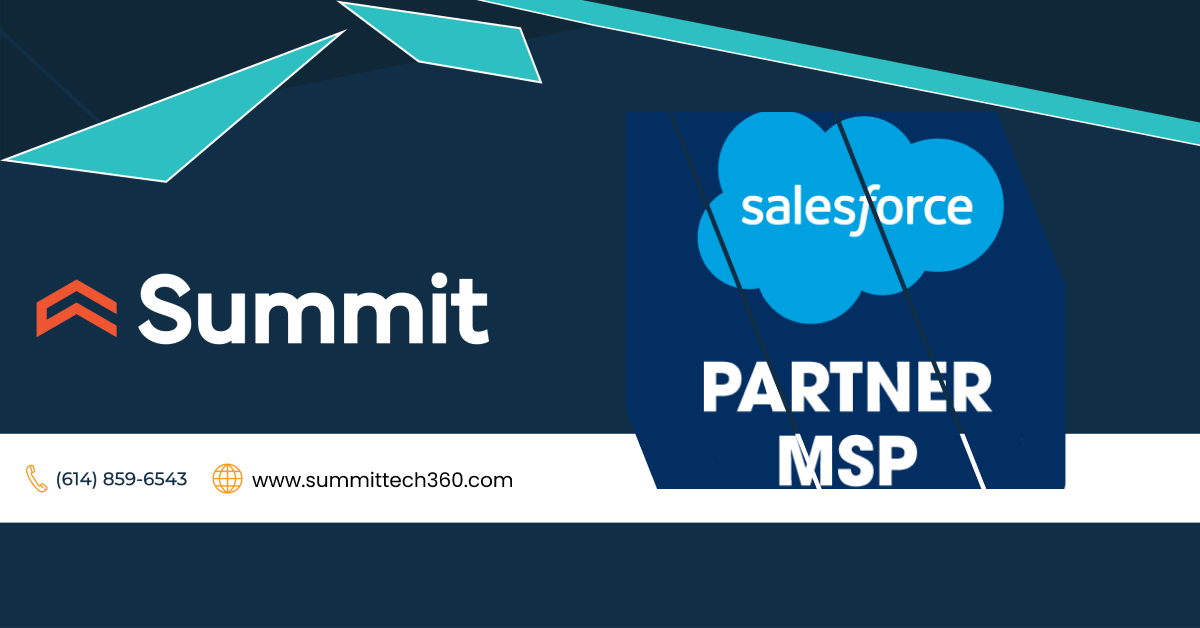Is your Salesforce investment underperforming? Here are 10 signs Salesforce Managed Services will help you maximize ROI, adoption, efficiency, and growth.
Introduction: When Your Salesforce Implementation Requires Additional Support
Salesforce powers more than 150,000 organizations worldwide, generating nearly $38 billion in revenue. For many companies, it serves as the backbone of sales, service, and marketing, enabling teams to collaborate, streamline processes, and make informed decisions.
But even the best technology isn’t “plug-and-play.” Without the right expertise, companies often struggle with:
- Low user adoption that limits ROI
- Inaccurate or inconsistent data across the business
- Missed opportunities to leverage Salesforce’s latest updates and new features
These issues don’t mean Salesforce is failing. They emphasize the need for more substantial, ongoing support to maximize the platform's potential.
That’s where Salesforce Managed Services come in: a way for organizations to keep Salesforce properly managed, supported, and optimized without overextending internal teams or adding costly headcount.
What Is Salesforce Managed Services?
Salesforce Managed Services refers to an ongoing partnership with certified Salesforce experts who oversee the day-to-day administration, support, and optimization of your CRM platform. By outsourcing these functions to a Salesforce Managed Services Provider (MSP), organizations ensure their platform remains reliable, scalable, and continuously aligned with evolving business priorities.
At a high level, managed services for Salesforce include:
- Administration: User management, security, permissions, and data quality.
- Support: Troubleshooting, resolving break/fix issues, and user assistance.
- Enhancements: Adding new features, workflows, automations, and integrations.
- Release Management: Preparing, testing, and deploying Salesforce updates.
- Strategy & Guidance: Aligning platform improvements to business goals.
Why Organizations Choose Managed Services
Outsourcing Salesforce management to a certified partner offers advantages that go far beyond one-time Salesforce consulting projects:
- Continuous optimization instead of short-term project work.
- Certified expertise on demand, including administrators, developers, architects, and analysts, without the overhead of hiring full-time specialists.
- Scalable support that flexes as your business grows and priorities shift.
- Proven best practices in governance, security, and performance management.
Key Benefits of Managed Services
Organizations that embrace Salesforce Managed Services achieve a variety of measurable benefits:
- More reliable data for accurate forecasting and reporting.
- Higher user adoption through ongoing training and responsive support.
- Improved agility to roll out new features and processes faster.
- Increased resilience by reducing single points of failure when internal staff leave.
- Increased scalability to support business growth and expansion.
- Continuity that keeps Salesforce running and aligned with business goals.
Salesforce Managed Services frees internal teams to focus on core business priorities, while certified Salesforce experts from the Salesforce MSP manage administration, integrations, performance improvements, and ongoing support. This approach streamlines operations and ensures your Salesforce investment continuously drives growth and efficiency.

The 10 Signs You Need Salesforce Managed Services
Salesforce Managed Services offer clear advantages, but timing is crucial. How do you know when your organization has reached the point where ongoing expert Salesforce management is no longer optional, but essential?
These 10 signs highlight when it’s time to consider engaging a Salesforce Managed Services Provider.
1. You Can’t Trust Your Salesforce Data
The First Red Flag: Data Doubt
Data trust is often the earliest signal that Salesforce isn’t delivering ROI. If user adoption slips, data quality quickly unravels. Suddenly:
- Ad-hoc spreadsheets creep back into meetings.
- You request a pipeline report and receive three different numbers.
- Forecasts feel more like guesswork than accurate insight.
What starts as minor inconsistencies snowballs into doubt. Leadership can’t rely on Salesforce to answer basic questions: What’s in the pipeline? Are we on track? Where should we invest?
The High Cost of Bad Data
Incomplete records, missing contacts, and outdated information aren’t just frustrating; they’re expensive.
Gartner estimates that poor data quality costs the average organization $12.9 million annually in lost revenue, rework, and missed opportunities. Source: .
Poor data leads to:
- Lost revenue because reps chase the wrong deals or miss follow-ups.
- Flawed decisions made based on inaccurate forecasts and incomplete insights
- Erosion of trust when leadership sees conflicting numbers.
How Managed Services Restore Confidence
Salesforce Managed Services don’t just clean up bad data—they prevent it by addressing the root cause: low adoption. Certified Salesforce experts can simplify page layouts, automate tedious tasks, enforce data standards, and enhance the user experience, making Salesforce the easiest place for teams to get work done.
The Result: Increased User Adoption and Data Quality
The chain reaction is powerful: better usability → increased user adoption → cleaner data. And when data is accurate and trusted, leaders can finally rely on Salesforce for precise forecasts and insights that drive confident, growth-focused decisions.

2. Your Team Is in a Constant State of Firefighting
The Warning Sign: Always Reacting
Look at your Salesforce admin’s or IT team’s calendar. Is it filled with strategic projects that move the business forward, or an endless cycle of password resets, bug fixes, and urgent tickets?
When teams are consumed by reactive tasks:
- Every hour spent on fixes is an hour not spent innovating.
- Support issues pile up while strategic initiatives stall.
- The opportunity cost grows larger than most leaders realize.
The Hidden Cost of Reactive Work
According to Asana’s Anatomy of Work index, knowledge workers spend 60% of their time on "work about work,"— chasing approvals, switching between tools, or managing tasks instead of doing strategic work. The impact? Missed deadlines, employee burnout, and productivity that flatlines.
For growth-focused companies, that means your best people are consumed by maintenance rather than creating value. Innovation slows, customer experience suffers, and leadership sees fewer results from a significant Salesforce investment.
How Managed Services Change the Equation
A Salesforce Managed Services Provider flips the model from reactive to proactive. With continuous monitoring, preventative maintenance, and expert processes, issues are identified and addressed before they impact the business. Instead of firefighting, your team benefits from stability, structure, and foresight.
The Result: More Focus on Growth
By outsourcing day-to-day Salesforce administration and providing proactive support, managed services free your internal talent to focus on projects that drive revenue, improve customer experiences, and accelerate growth.
The shift is dramatic: when Salesforce admins spend 80% of their time on strategy instead of support tickets, the platform becomes a true engine for growth—not a daily drain on resources.

3. Your Salesforce Admin is a Single Point of Failure
The Warning Sign: Overreliance
Many companies rely on one or two “Salesforce gurus” who hold all the institutional knowledge. They’re brilliant and indispensable—and that’s exactly the problem.
What happens when your only admin goes on vacation, takes sick leave, or leaves the company altogether? Projects stall, fixes are delayed, and valuable knowledge walks out the door.
This isn’t just a resource gap. It’s a serious business continuity risk.
Why Over-Reliance Is Risky
The talent market only exacerbates this challenge. Research from IDC projects that the Salesforce ecosystem will create 9.3 million new jobs globally by 2026. This massive demand makes it harder and more expensive to recruit and retain the specialized Salesforce expertise needed.
At the same time, Gartner reports that IT executives now identify talent shortages as the #1 barrier to adopting 64% of emerging technologies—up sharply from just 4% in 2020
When all your Salesforce knowledge sits with a single individual or even a small internal team, the risk is amplified. Backfilling is difficult, scaling is nearly impossible, and the organization becomes fragile.
For executives, that means stalled innovation, spiraling costs, and a fragile dependency that threatens long-term success.
How Managed Services Build Resilience
A Salesforce Managed Services Provider eliminates the “single point of failure.” Instead of relying on a single admin or Salesforce generalist, you gain access to an entire team of certified administrators, developers, architects, and analysts who:
- Provide redundancy to ensure work continues even if someone is unavailable.
- Bring breadth of expertise, ensuring the right specialist is available for every challenge.
- Scale seamlessly with your business without ballooning internal headcount.
The Result: Stability and Confidence
Instead of relying on one or two key people for your Salesforce operations, you gain stability, predictability, and resilience. Managed services ensure projects stay on track, fixes get done, and your business keeps moving forward—no matter who’s in the office.
Sidebar: While Salesforce consulting firms or consulting partners may step in for focused project-based needs, a Salesforce Managed Services Provider delivers ongoing, embedded expertise that extends your team and increases resilience.
4. Your Salesforce Environment is Stagnating
The Warning Sign: Salesforce Hasn’t Evolved
Markets shift. Products evolve. Sales strategies adapt. But if your Salesforce instance looks the same as it did two years ago, that’s a red flag. A static CRM in a dynamic business doesn’t just fail to add value; it becomes a drag.
Executives often see the fallout firsthand:
- Sales teams complain that Salesforce doesn’t reflect how they actually sell.
- Marketing can’t fully leverage new campaign tools or integrations with other critical systems.
- Leadership loses confidence because Salesforce information feels like “old news” rather than a strategic asset.
When Salesforce stands still, your business slows too.
The Cost of Standing Still
A stagnant platform creates more than frustration; it creates risk. New Salesforce features are released three times a year. Fall behind, and your organization misses out on automation, AI, analytics, and efficiency gains competitors are already using.
The result?
- Missed opportunities: new capabilities go unused while competitors gain an edge
- Rising costs: teams build manual workarounds instead of using built-in tools
- Lower adoption: users disengage, reinforcing the cycle of stagnation
For business leaders, that means an investment in a powerful technology risks becoming just another underutilized expense.
Sidebar: Effective release management and ongoing support ensure your business adopts new Salesforce features quickly while keeping the platform secure, efficient, and aligned with your goals.
How Managed Services Keep Salesforce Moving Forward
Managed services transform Salesforce from a static to a strategic platform. Instead of reacting to requests, you gain a proactive roadmap that ensures every enhancement ties to your business priorities. A dedicated team of Salesforce experts helps you:
- Stay current with Salesforce’s regular releases
- Roll out new features and functionality at the right time
- Align platform changes with evolving sales, service, and marketing strategies
- Continuously refine Salesforce so it grows alongside the business
The Result: Salesforce as a Launchpad
With managed services, Salesforce transforms from a static system into a launchpad for growth. Your platform scales with business demands, stays optimized through every release, and continuously fuels innovation. Instead of slowing you down, it becomes a driver of agility, momentum, and long-term success.

5. Your Innovation Backlog is a Morale Killer
The Warning Sign: Ideas Go Nowhere
Your team sees opportunities every day; ways to streamline processes, improve customer experiences, and unlock new value. They submit those ideas with enthusiasm, only to watch them disappear into an endless backlog.
Six months later, nothing has moved. The message is clear: innovation isn’t a priority. The backlog stops being a to-do list and starts being a bottleneck. Progress slows, morale erodes, and employees stop speaking up altogether.
The Cost of a Stalled Backlog
For executives, this isn’t just a morale issue; it’s a performance issue:
- Lost efficiency: process improvements and automation ideas go unimplemented
- Disengaged teams: employees stop raising ideas, and valuable insights from the front lines are lost
- Slow customer response: service and sales improvements stall while competitors move faster
- Cultural damage: teams begin to see Salesforce as a barrier, not an enabler
According to Gallup, companies with highly engaged employees see 23% higher profitability than those with disengaged teams. Source: When innovation is consistently stalled, that profitability gap widens.
How Managed Services Clear the Bottleneck
Managed services provide the dedicated, predictable capacity required to sustain innovation. Instead of forcing teams to choose between firefighting and progress, a managed services partner ensures that:
- Backlogged requests are prioritized and executed.
- Enhancements are aligned with business strategy, not just “nice-to-haves.”
- Innovation is steady and measurable, not sporadic and reactive.
- Teams see their ideas come to life, reinforcing a culture of contribution.
The Result: A Culture of Progress
When ideas consistently become reality, employees stay engaged, morale improves, and Salesforce evolves in tandem with the creativity of your people. Leaders gain more than a motivated workforce; they get a platform that keeps pace with business needs and a culture where innovation is not the exception, but the expectation.
6. Your Technical Debt is Mounting
The Warning Sign: Quick Fixes That Pile Up
Shortcuts may save time in the moment, but they add up over months—or years—into technical debt: the hidden complexity that slows your team and quietly inflates costs.
Maybe it’s the unmanaged code left behind by a former developer. Or the 500 workflow rules that should really be one streamlined Flow. Whatever the cause, the impact is the same:
- Salesforce gets harder to manage.
- Enhancements take longer and cost more.
- Every new project feels less like building for the future and more like digging through layers of outdated workarounds.
The Cost of Technical Debt
Technical debt isn’t just inconvenient; it’s expensive. McKinsey estimates that technical debt quietly consumes up to 40% of IT budgets and forces companies to spend an extra 10–20% on new projects just to fix existing issues.
For business leaders, that translates into:
- Rising project costs as teams burn time fixing the past before tackling the future.
- Delayed innovation as new initiatives stall under the weight of old problems.
- Lost agility as Salesforce slows instead of enabling faster change.
Left unchecked, technical debt becomes a silent tax on growth.
How Managed Services Reduce Debt and Restore Agility
Managed Services tackle technical debt head-on. Through regular Salesforce health checks, code refactoring, and cleanup of outdated automations, your Salesforce org becomes simpler, more stable, and aligned with current best practices. With proactive monitoring, new debt is identified early and addressed before it slows you down.
Regular maintenance of Salesforce activities is equally critical. By keeping configurations clean, processes current, and releases properly managed, you prevent new technical debt from accumulating and ensure your platform stays optimized for long-term business needs.
The Result: Speed and Scalability
Instead of a brittle, costly system weighed down by technical debt, you gain a Salesforce platform that is:
- Agile enough to adapt quickly to new strategies and market demands
- Scalable to support ongoing business growth and expansion
- Cost-efficient, with projects delivered faster and fewer cycles lost to rework
The outcome is clear: Salesforce shifts from being a liability that slows progress to an asset that accelerates innovation, growth, and long-term ROI.

7. You’re Missing Out on New Salesforce Releases
The Warning Sign: Innovation Left on the Table
Three or more times a year, Salesforce rolls out hundreds of new features: tools designed to boost productivity, enhance analytics, strengthen security, and improve customer experiences.
But here’s the reality: most companies barely scratch the surface with new releases. Internal teams are too busy handling tickets and routine requests to research, test, and roll out new functionality. The result?
- Features you’re already paying for go unused.
- Teams rely on outdated processes while better options sit idle.
- Competitors adopt innovations faster, turning them into an advantage.
The Cost of Falling Behind
Missing Salesforce releases doesn’t just waste value; it slows your business:
- Lost productivity: new automation, AI, and analytics features could be saving hours, but remain untouched.
- Higher risk: security and compliance enhancements aren’t implemented.
- Competitive disadvantage: while your platform stagnates, competitors capitalize on tools that improve customer engagement, forecasting, and agility.
In short, the innovation you’ve already purchased often goes underutilized, while costs and risks accumulate.
How Managed Services Keep You Current
Salesforce Managed Services Providers live and breathe the Salesforce ecosystem. They understand which new features deliver the greatest impact for your industry, test them thoroughly, and deploy them with minimal disruption.
A comprehensive managed services model includes proactive release management, keeping your platform current with every Salesforce update and ensuring new capabilities are put to work—not left on the shelf.
Instead of falling behind or scrambling to catch up, you gain:
- A clear roadmap for each release cycle
- Feature adoption prioritized around business goals and measurable outcomes
- Confidence that your org stays secure, efficient, and competitive
The Result: Always Ahead, Never Behind
With Salesforce Managed Services, your platform evolves in step with your business instead of falling behind it. Each release becomes an opportunity to unlock new value—driving adoption, strengthening performance, and giving you a competitive edge.
The result is a Salesforce environment that grows as fast as your business and continuously delivers on its investment.

8. The User Experience (UX) is Clunky and Inefficient
The Warning Sign: Salesforce Feels Harder to Use Than It Should
When a platform feels cumbersome, adoption suffers—and Salesforce is no exception. If logging a call takes a dozen clicks or updating a deal feels like busywork, users disengage. The result?
- Incomplete data that undermines reporting
- Teams reverting to spreadsheets outside Salesforce
- Delayed updates that make dashboards and forecasts unreliable
That friction compounds over time. Productivity slows, data quality declines, and what should be a powerful growth engine turns into a tool employees resist using.
The Cost of Poor UX
Clunky experiences don’t just frustrate employees; they undermine Salesforce’s ROI. Poor adoption means incomplete data, unreliable reports, and wasted investment.
According to Nucleus Research, adoption is the single most important factor in determining CRM success and ROI.
If Salesforce feels like a chore, adoption plummets. And when adoption plummets, so does return on investment. For business leaders, that translates into:
- Lower adoption: if reps don’t use Salesforce, leaders lose visibility into performance.
- Bad data: inconsistent updates make reports unreliable.
- Lost productivity: too many clicks and manual steps waste valuable time.
- Employee dissatisfaction: frustration grows when tools feel like obstacles, not enablers.
The outcome? Higher costs, lower output, and a platform that quietly undermines strategy instead of fueling it.
How Managed Services Simplify Salesforce
Salesforce Managed Services removes these roadblocks by making Salesforce easier to use—and easier to love. Through thoughtful design and continuous optimization, certified experts:
- Streamline page layouts so users see only what matters
- Automate repetitive tasks so processes move faster
- Build workflows that align with how teams actually work
- Ensure seamless data flow between Salesforce and other business tools
- Continuously refine the user experience based on feedback
The Result: User Adoption That Sticks
When Salesforce is intuitive and straightforward, employees stop working around it and start working in it. Leaders gain higher adoption, cleaner data, and more productive teams, powered by a platform that finally supports the way business gets done.

9. Strategic Salesforce Projects Keep Stalling
The Warning Sign: Ambition Outpaces Capacity
Salesforce isn’t just a CRM platform; it’s a powerful solution designed to scale with your business. But advanced initiatives like CPQ implementations, Marketing or Industry Cloud rollouts, or AI-driven automation initiatives often get stuck halfway.
Why? Most in-house Salesforce admins are strong generalists, but these projects demand specialized expertise across areas like architecture, integrations, and change management. Without it, projects stall, deadlines slip, and costs quietly climb.
Executives see the pattern clearly: big ambitions, little progress.
The Cost of Stalled Projects
When Salesforce projects stall, the consequences extend well beyond IT. The business impact is both immediate and long-lasting:
- Lost revenue opportunities: delayed CPQ rollout means slower quoting and fewer deals closed.
- Rising costs: scope creep and rework eat into budgets.
- Eroded confidence: leadership grows frustrated as promised ROI never materializes.
- Underused investment: Salesforce becomes an expensive system of record, not a growth engine.
Delays in Salesforce implementations also disrupt broader business process optimization initiatives, making it harder to align teams, coordinate workstreams, and achieve overall project success.
According to PMI research, organizations waste 11.4% of their project investment due to poor performance, and stalled Salesforce initiatives are a prime example of how that waste shows up in real budgets and real outcomes.
How Managed Services Unlock Expertise on Demand
Salesforce Managed Services eliminate the roadblocks that come with limited internal capacity by giving you on-demand access to a full bench of certified specialists. This ensures you always have the right expertise, exactly when you need it.
That means no stalled projects, no costly trial-and-error—just expert execution in areas such as:
- Complex CPQ configuration: Streamlining pricing, quoting, and approvals to accelerate deals.
- System integrations: Connecting Salesforce with ERP, marketing automation, or other business-critical platforms.
- Cloud rollouts: Expanding into Marketing Cloud, Industry Cloud, or Experience Cloud without disruption.
- AI and automation adoption: Deploying new Salesforce AI features to enhance productivity and customer insights.
In addition, the right Salesforce Managed Services Provider can support the entire Salesforce ecosystem, including connecting Salesforce with other critical systems, ensuring seamless integration, optimized performance, and ongoing alignment with your business strategy.
The Result: Projects That Actually Ship
With Salesforce Managed Services, stalled initiatives turn into completed milestones. Instead of delays and mounting costs, you gain consistent momentum. Projects move forward, innovation accelerates, and your Salesforce platform fulfills its promise as a growth engine.
10. Your Salesforce ROI Is Unclear or Disappointing
The Warning Sign: When Results Don’t Add Up
At the leadership level, Salesforce isn’t judged by its features or configurations; it’s judged by its ourcomes. Leadership approved the investment, expecting:
- Faster, more predictable sales cycles
- Stronger customer retention
- Leaner, more efficient operations
But if you can’t clearly tie Salesforce to those outcomes, it’s a red flag. For many organizations, the earlier signs—low adoption, messy data, firefighting, technical debt—compound until ROI becomes murky. And when results aren’t visible, confidence at the leadership table erodes.
The Cost of Unclear ROI
Unclear ROI doesn’t just frustrate leaders; it creates real business risk:
- Budget risk: Executives begin questioning whether Salesforce deserves continued funding.
- Strategic risk: Future projects and initiatives lose support without proof of value.
- Competitive risk: While your investment stagnates, competitors use theirs to drive measurable growth.
According to Nucleus Research, organizations achieve an average return of $3.10 for every dollar spent on CRM deployments. To capture (or exceed) that return, however, adoption, data quality, and ongoing optimization must be in place.
What Managed Services Should Deliver
Not all managed services offerings address this issue. Too often, managed services providers focus narrowly on tickets and break/fix tasks. That keeps Salesforce running, but it doesn’t connect the platform to measurable business outcomes.
A basic managed service provider may only handle routine support. In contrast, a top-tier Salesforce MSP like Summit acts as a strategic partner, offering proactive management, seamless integrations, and ongoing optimization to maximize the value of Salesforce. They support businesses by aligning Salesforce with their goals, driving adoption, and helping maximize ROI.
The right Salesforce MSP should:
- Prioritize adoption and user experience so data is complete, accurate, and actionable
- Align Salesforce enhancements to business KPIs
- Proactively optimize workflows and integrations to improve efficiency and agility
- Facilitate leadership-level reporting that proves Salesforce’s impact quarter after quarter
How Summit Approaches ROI
At Summit, we believe Salesforce Managed Services must go above and beyond support: it should be a strategic extension of your team.
As a Summit-tier Salesforce Managed Services Provider, we combine deep Salesforce expertise across administration, development, and architecture to ensure your platform is managed, supported, optimized, and scaled for measurable outcomes.
Our certified Salesforce experts focus on adoption, optimization, and measurable outcomes. Every initiative and enhancement is tied back to revenue growth, customer retention, or operational efficiency.
The Result: ROI You Can Prove
With the right approach, Salesforce evolves from a system of record into a growth engine that leadership can trust. You gain clarity, a measurable ROI, and confidence that your investment is fueling long-term success—not just “keeping the lights on.”

From Cost Center to Growth Engine: The Path Forward
If these signs sound familiar, your Salesforce investment isn’t failing—it’s underperforming because it isn’t being actively managed as a strategic asset.
The difference is clear:
- Organizations that treat Salesforce as “software to maintain” fall into a costly, reactive cycle.
- Those that invest in Salesforce Managed Services unlock a platform that evolves with the business, empowers users, and drives measurable growth.
Protecting and Maximizing Your Investment
Engaging a Salesforce Managed Services partner is a strategic choice. It’s how you shift:
- From break-fix support to proactive improvement
- From single points of failure to resilience and depth of expertise
- From unclear ROI to measurable results you can prove
With the right partnership, Salesforce becomes more than a system of record—it becomes a growth engine fueling revenue, efficiency, and competitive advantage.
Summary Table: The Signs, the Solutions, and the Payoff
Think of Managed Services as a direct response to the Salesforce challenges most business leaders face. Each pain point has a clear path to improvement—and measurable ROI impact:
Pain Point (Sign) |
Benefits of Salesforce Managed Services |
ROI Impact |
1. Can’t trust your Salesforce data |
Clean, consistent, and trusted data | Reliable forecasts and confident decisions |
2. Team stuck firefighting |
Proactive monitoring and admin support | More time for strategic, revenue-driving work |
3. Single point of failure (1–2 internal resources) |
Access to a full team of certified experts | Reduced risk, uninterrupted operations |
4. Platform is stagnant |
Strategic roadmap and continuous updates | Salesforce evolves with business needs |
5. Innovation backlog piling up |
Dedicated, predictable capacity | Faster delivery of new features and improvements |
6. Mounting technical debt |
Regular maintenance and best-practice cleanups | Lower long-term costs, greater agility |
7. Missing Salesforce releases |
Expert-led release and feature adoption | Competitive advantage with new tools |
8. Clunky user experience |
Streamlined layouts, automation, and workflows | Higher adoption, productivity gains |
9. Stalled strategic projects |
On-demand specialists across Salesforce Clouds | Faster project completion at lower cost |
10. Unclear or disappointing ROI |
Active management aligned to business goals | Prove and increase Salesforce ROI |
Ready to Get More from Salesforce?
If your organization is ready to protect its Salesforce investment, accelerate innovation, and deliver the ROI leadership expects, now is the time to rethink how the platform is managed.
Summit’s Salesforce Managed Services team provides the certified expertise, proactive support, and strategic Salesforce guidance needed to transform Salesforce into the growth engine it was designed to be.
Contact the Summit Team Today for a No-Obligation Consultation



























